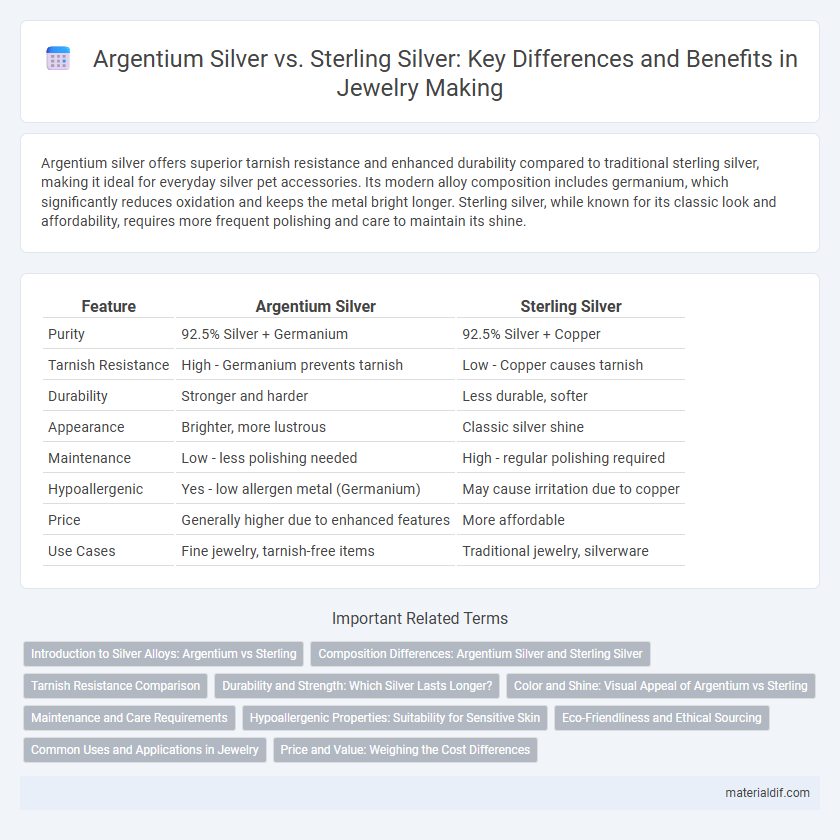Argentium silver offers superior tarnish resistance and enhanced durability compared to traditional sterling silver, making it ideal for everyday silver pet accessories. Its modern alloy composition includes germanium, which significantly reduces oxidation and keeps the metal bright longer. Sterling silver, while known for its classic look and affordability, requires more frequent polishing and care to maintain its shine.
Table of Comparison
| Feature | Argentium Silver | Sterling Silver |
|---|---|---|
| Purity | 92.5% Silver + Germanium | 92.5% Silver + Copper |
| Tarnish Resistance | High - Germanium prevents tarnish | Low - Copper causes tarnish |
| Durability | Stronger and harder | Less durable, softer |
| Appearance | Brighter, more lustrous | Classic silver shine |
| Maintenance | Low - less polishing needed | High - regular polishing required |
| Hypoallergenic | Yes - low allergen metal (Germanium) | May cause irritation due to copper |
| Price | Generally higher due to enhanced features | More affordable |
| Use Cases | Fine jewelry, tarnish-free items | Traditional jewelry, silverware |
Introduction to Silver Alloys: Argentium vs Sterling
Argentium silver is a modern alloy containing copper, silver, and a small amount of germanium, which enhances its tarnish resistance and durability compared to traditional sterling silver, which comprises 92.5% pure silver and 7.5% copper. The addition of germanium in Argentium silver improves its hardness and allows for easier maintenance, making it popular in contemporary jewelry and silverware. Sterling silver remains a classic choice valued for its rich luster and malleability, but it requires more frequent polishing due to its tendency to tarnish over time.
Composition Differences: Argentium Silver and Sterling Silver
Argentium Silver contains a minimum of 92.5% silver, similar to Sterling Silver, but incorporates 1.0-1.3% germanium instead of copper, enhancing tarnish resistance and durability. Sterling Silver typically consists of 92.5% silver and 7.5% copper, which contributes to its traditional strength but makes it more prone to oxidation and discoloration. The addition of germanium in Argentium Silver significantly reduces tarnishing and improves soldering characteristics compared to the copper alloy in Sterling Silver.
Tarnish Resistance Comparison
Argentium Silver offers superior tarnish resistance compared to traditional Sterling Silver due to its higher purity and the inclusion of germanium, which forms a protective oxide layer preventing sulfur-induced tarnish. Sterling Silver, composed of 92.5% silver and 7.5% other metals like copper, is more prone to tarnishing as the copper reacts with environmental pollutants. The enhanced tarnish resistance of Argentium Silver reduces maintenance frequency, making it a preferred choice for jewelry and silverware exposed to atmospheric contaminants.
Durability and Strength: Which Silver Lasts Longer?
Argentium Silver offers superior durability and tarnish resistance compared to traditional Sterling Silver due to its unique alloy composition containing germanium. This enhanced strength makes Argentium Silver less prone to scratching, bending, and corrosion, ensuring longer-lasting jewelry and silverware. Sterling Silver, while popular for its classic appearance, requires more frequent maintenance and polishing to prevent tarnish and wear over time.
Color and Shine: Visual Appeal of Argentium vs Sterling
Argentium Silver offers a brighter, whiter color and retains its shine longer than traditional Sterling Silver, which tends to develop a darker patina over time. The unique alloy composition of Argentium, containing germanium, enhances its tarnish resistance and maintains a polished, lustrous finish with minimal maintenance. Sterling Silver, composed mainly of silver and copper, provides classic beauty but requires frequent cleaning to preserve its shine and prevent discoloration.
Maintenance and Care Requirements
Argentium Silver offers superior tarnish resistance compared to Sterling Silver, reducing the frequency and effort needed for cleaning. Its unique blend containing germanium enhances durability and minimizes oxidation, allowing for easier maintenance with just occasional polishing. Sterling Silver requires regular cleaning to prevent tarnish buildup, often demanding more intensive care to preserve its shine and quality.
Hypoallergenic Properties: Suitability for Sensitive Skin
Argentium Silver contains a higher purity of silver and a unique alloy of germanium, reducing tarnish and enhancing hypoallergenic properties, making it ideal for sensitive skin. Sterling Silver, typically made of 92.5% silver and 7.5% copper, may cause irritation or allergic reactions due to the copper content. Argentium's hypoallergenic profile and tarnish resistance provide a safer and more comfortable option for those prone to metal allergies.
Eco-Friendliness and Ethical Sourcing
Argentium Silver offers a more eco-friendly alternative to traditional Sterling Silver by reducing the need for toxic plating processes and lowering metal waste through its improved resistance to tarnish. Sterling Silver often involves silver mined under less stringent ethical standards, whereas Argentium Silver is commonly sourced from suppliers committed to ethical mining practices that minimize environmental impact. Choosing Argentium Silver supports sustainable jewelry production by promoting both environmental responsibility and ethical sourcing in the silver industry.
Common Uses and Applications in Jewelry
Argentium Silver is prized in jewelry for its superior tarnish resistance and ease of maintenance, making it ideal for everyday wear items such as rings, bracelets, and earrings. Sterling Silver, composed of 92.5% pure silver, remains a popular choice for classic and intricate designs due to its traditional luster and workability. Both metals are commonly used in fine jewelry, but Argentium Silver's durability extends its appeal to pieces exposed to frequent handling and moisture.
Price and Value: Weighing the Cost Differences
Argentium Silver typically commands a higher price than Sterling Silver due to its enhanced tarnish resistance and durability, offering better long-term value. Sterling Silver, while more affordable, requires frequent maintenance to prevent oxidation and maintain its appearance. Consumers often weigh Argentium's premium cost against its lower upkeep and extended lifespan when considering overall value.
Argentium Silver vs Sterling Silver Infographic

 materialdif.com
materialdif.com